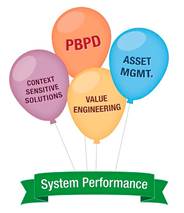
AUGUST 2015 • https://www.fhwa.dot.gov/goshrp2/
What is PBPD?
PBPD is a decision-making approach that helps agencies better manage transportation investments and serve system-level needs and performance priorities with limited resources. Building upon Context Sensitive Solutions, flexibility in design, Practical Design, Asset Management, and Value Engineering, PBPD helps agencies expand the focus from cost-saving, short-term solutions to improving and evaluating overall system performance.
How is PBPD Different?
The PBPD approach uses quantitative analyses to guide decision-making throughout the project development process. Advances in data collection technology have improved the availability and reliability of data. The use of such data is stressed in the data-driven performance measures in Moving Ahead for Progress in the 21st Century Act (MAP-21) legislation. Emerging growth of analysis tools using such data enables agencies to better evaluate projects within important program areas. As a result, the Federal Highway Administration (FHWA) encourages States to plan and develop projects with a system performance mindset. This is not new regulation, but rather a mindset that considers all roadway users, including pedestrians and bicyclists.
| ANALYSIS TOOLS | |
|---|---|
| Safety | Operational |
| Safety Analyst | Traffic Simulation |
| Highway Safety Manual | Highway Capacity Manual |
| Interactive Highway Safety Design Model | Integrated Corridor Management |
Analysis is a key component of PBPD. Many projects include a stated or implied goal of improving operations or safety; however, the State or local agency does not always have enough data to know whether a proposed project would actually accomplish that goal or whether a completed project has achieved its stated purpose. The use of appropriate analysis tools, as shown in the table, will allow agencies to effectively evaluate and compare the performance of various alternatives.
FHWA embraces the PBPD approach and developed a team specifically designated to raise awareness of PBPD by supporting States’ interested in PBPD, promoting the use of existing design flexibility along with performance analysis tools, and developing and disseminating information. The best place to find PBPD information is on FHWA’s website: https://www.fhwa.dot.gov/design/pbpd/. This website includes:
